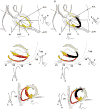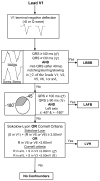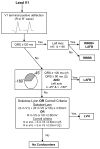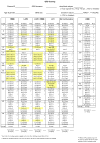A detailed guide for quantification of myocardial scar with the Selvester QRS score in the presence of electrocardiogram confounders
- PMID: 21872001
- PMCID: PMC3164517
- DOI: 10.1016/j.jelectrocard.2011.06.008
A detailed guide for quantification of myocardial scar with the Selvester QRS score in the presence of electrocardiogram confounders
Abstract
The Selvester QRS score translates subtle changes in ventricular depolarization measured by the electrocardiogram into information about myocardial scar location and size. This estimated scar has been shown to have a high degree of correlation with autopsy-measured myocardial infarct size. In addition, multiple studies have demonstrated the value of the QRS score in post-myocardial infarct patients to provide prognostic information. Recent studies have demonstrated that increasing QRS score is predictive of increased implantable defibrillator shocks for ventricular tachycardia and fibrillation as well as decreased response to cardiac resynchronization therapy. Although QRS scoring has never achieved widespread clinical use, increased interest in patient selection and risk-stratification techniques for implantable defibrillators and cardiac resynchronization therapy has led to renewed interest in QRS scoring and its potential to identify which patients will benefit from device therapy. The QRS score criteria were updated in 2009 to expand their use to a broader population by accounting for the different ventricular depolarization sequences in patients with bundle-branch/fascicular blocks or ventricular hypertrophy. However, these changes also introduced additional complexity and nuance to the scoring procedure. This article provides detailed instructions and examples on how to apply the QRS score criteria in the presence of confounding conduction types to facilitate understanding and enable development and application of automated QRS scoring.
Published by Elsevier Inc.
Figures








References
-
- Selvester R, Wagner J, Rubin H. Quantitation of myocardial infarct size and location by electrocardiogram and vectorcardiogram. Quantitation in cardiology. 1972:31.
-
- Strauss DG, Cardoso S, Lima JA, Rochitte CE, Wu KC. ECG scar quantification correlates with cardiac magnetic resonance scar size and prognostic factors in Chagas' disease. Heart. 2011;97:357–61. - PubMed
-
- Wagner GS, Freye CJ, Palmeri ST, et al. Evaluation of a QRS scoring system for estimating myocardial infarct size. I. Specificity and observer agreement. Circulation. 1982;65:342–7. - PubMed
-
- Ideker RE, Wagner GS, Ruth WK, et al. Evaluation of a QRS scoring system for estimating myocardial infarct size. II. Correlation with quantitative anatomic findings for anterior infarcts. Am J Cardiol. 1982;49:1604–14. - PubMed
Publication types
MeSH terms
Grants and funding
LinkOut - more resources
Full Text Sources
Medical

